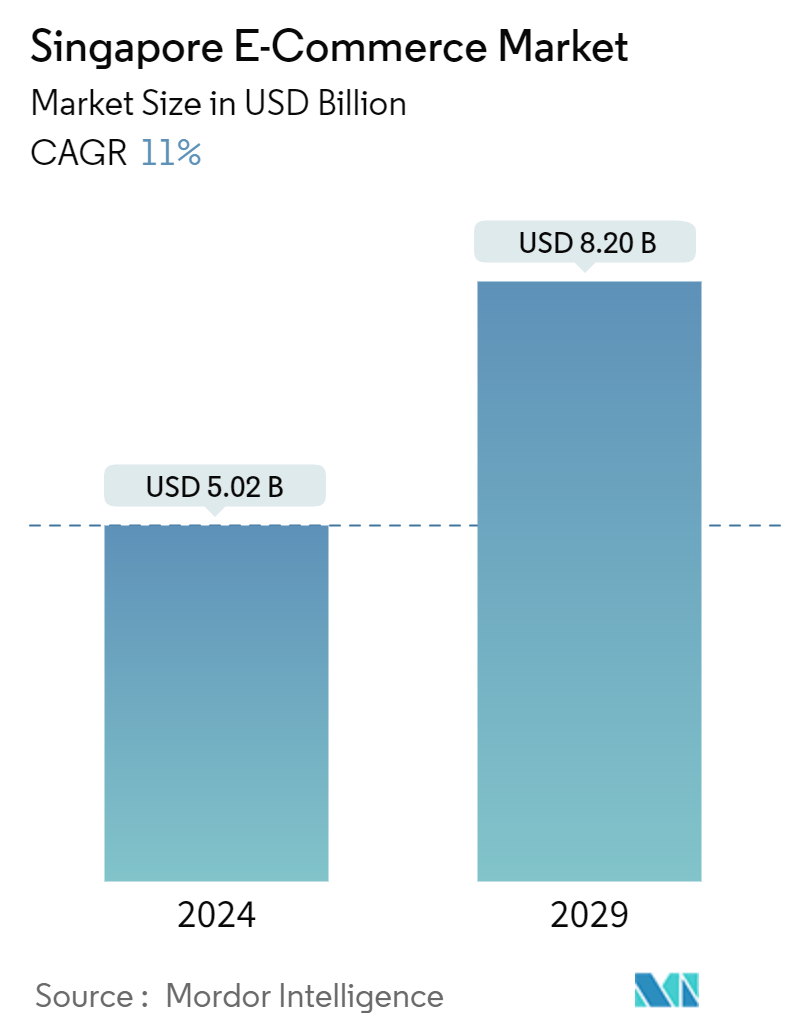Market Size of Singapore E-Commerce Industry

| Study Period | 2019 - 2029 |
| Base Year For Estimation | 2023 |
| Market Size (2024) | USD 5.02 Billion |
| Market Size (2029) | USD 8.20 Billion |
| CAGR (2024 - 2029) | 11.00 % |
| Market Concentration | Low |
Major Players
*Disclaimer: Major Players sorted in no particular order |
Singapore E-Commerce Market Analysis
The Singapore E-Commerce Market size is estimated at USD 5.02 billion in 2024, and is expected to reach USD 8.20 billion by 2029, growing at a CAGR of 11% during the forecast period (2024-2029).
- The rise of technology has ushered in a new age in the realm of business, and Singapore has readily welcomed this transformation. The expansion of e-commerce in Singapore has been extraordinary, as an increasing number of enterprises are shifting toward online channels to connect with their clientele. E-commerce platforms in the area are playing a vital role in enabling businesses to flourish in the digital sphere by facilitating the management of online marketplaces.
- The surge in the region's e-commerce market can be attributed to the growing popularity of mobile payment methods. With options like digital wallets, code-scanning payments, and mobile payments, users can conveniently and securely make purchases on their mobile devices. The rising use of mobile wallets in Singapore is a clear indication of the widespread acceptance of mobile payments. Additionally, the increasing internet connectivity in the region is playing a significant role in driving the adoption of mobile payment technologies. As mobile payments continue to gain traction, the e-commerce market in the region is poised for growth.
- Buy now pay later (BNPL) is a payment method that is gaining traction in the Singaporean e-commerce industry. By incorporating BNPL into their payment options, e-commerce websites can cater to a wider range of consumers, particularly the younger demographic. This allows consumers to receive their purchases upfront and make payments in installments based on their circumstances, enhancing the overall convenience and satisfaction of the shopping experience. The adoption of BNPL is increasing among both online platforms and brick-and-mortar stores, indicating a positive trend toward the expansion of the e-commerce market in the region.
- According to the International Trade of Administration (ITA), Singapore's e-commerce industry is experiencing rapid growth thanks to its widespread, high-speed, and reliable ICT infrastructure, as well as its tech-savvy population and the government's commitment to embracing the digital economy and achieving its goal of becoming a Smart Nation. The Government of Singapore is actively encouraging companies to utilize IT to enhance and grow their businesses. The growing government efforts to drive the e-commerce industry in the region are anticipated to be a major factor in the market's expansion.
- Moreover, according to the ITA, the gross merchandise volume of the Singaporean e-commerce market reached USD 8.2 billion in 2022, with forecasts suggesting an increase to USD 11 billion by 2025. Over the recent years, computer and telecommunications equipment have held a substantial portion of online sales, while furniture and household equipment have also secured a significant share. Other major product categories in the market studied include fashion, food, cosmetics and personal care, and toys. The substantial investments made by the e-commerce platforms in the region are also playing a significant role in the market's growth.
- The e-commerce market in Singapore places a greater emphasis on the quality and pricing of goods than its surrounding nations. Temasek Holdings reported that the gross merchandise volume (GMV) of the Singaporean e-commerce market reached USD 8 billion in 2023, with projections to hit USD 10 billion by 2025. Singapore has solidified its position as Southeast Asia's most advanced e-commerce market.
- The rise of social e-commerce is gaining more importance. By integrating social media, social e-commerce platforms have effectively merged the social aspect with the shopping aspect to cater to the evolving social and shopping demands of customers. With ongoing technological advancements and shifts in consumer behavior, e-commerce is projected to expand rapidly through social media promotions and play a progressively vital role in Singapore's e-commerce industry. Moreover, e-commerce websites will persist in evolving and innovating to meet the changing needs of consumers and keep up with the rapid advancements in technology.
- Following the COVID-19 pandemic, the Singaporean e-commerce market experienced a profound transformation. Changes in consumer behavior were accelerated, digital engagement surged, and competition intensified. The future landscape of e-commerce in Singapore is anticipated to be shaped by omni-channel approaches, social commerce, and advancements in logistics and delivery services. Government involvement is expected to be pivotal in determining the trajectory of Singapore's e-commerce industry.
Singapore E-Commerce Industry Segmentation
Electronic commerce (e-commerce) is a business model that allows consumers and businesses to buy and sell goods and services over the internet.
The Singaporean e-commerce market is segmented by B2C e-commerce and B2B e-commerce. By B2C e-commerce, the market is segmented into beauty and personal care, consumer electronics, fashion and apparel, food and beverage, furniture and home. For each segment, the market sizes and forecasts are provided in terms of value (USD).
| By B2C E-commerce | ||||||||
| Market Size (GMV) for the Period of 2022-2029 | ||||||||
|
| By B2B E-commerce | |
| Market Size (GMV) for the Period of 2022-2029 |
Singapore E-Commerce Market Size Summary
The e-commerce market in Singapore is experiencing significant growth, driven by the increasing adoption of online sales channels and the strategic positioning of the country as a regional logistics hub. The market is characterized by the presence of major players like Shopee and Lazada, which utilize innovative strategies such as live streaming to engage customers effectively. The high internet penetration rate, supported by advanced digital infrastructure and high-speed broadband connections, has facilitated the widespread adoption of e-commerce across various demographics. Singapore's role as a cross-border e-commerce hub is further enhanced by its geographic location, allowing consumers to access global platforms for cost-effective shopping. The market is also witnessing a shift towards mobile-first strategies, with companies like Carousell expanding their services to cater to both mobile and desktop users.
The competitive landscape of Singapore's e-commerce market is marked by the presence of several ASEAN unicorns and the continuous expansion of digital payment solutions. The government's initiatives to drive digital transformation and resilience post-pandemic, along with the Singapore Green Plan 2030, are expected to further bolster the market. The introduction of 5G technology is anticipated to enhance connectivity and scalability, providing a boost to online shopping experiences. Additionally, the market is seeing increased investment and acquisitions, such as WEBUY's acquisition of Chilibeli, which aim to optimize supply chains and expand market reach. Regulatory measures, including the E-commerce Marketplace Transaction Safety Ratings, are being implemented to ensure transaction safety and user authenticity, contributing to a more secure online shopping environment.
Singapore E-Commerce Market Size - Table of Contents
-
1. MARKET INSIGHTS
-
1.1 Market Overview
-
1.2 Industry Attractiveness-Porter's Five Forces Analysis
-
1.2.1 Bargaining Power of Suppliers
-
1.2.2 Bargaining Power of Buyers/Consumers
-
1.2.3 Threat of New Entrants
-
1.2.4 Threat of Substitute Products
-
1.2.5 Intensity of Competitive Rivalry
-
-
1.3 Key Market Trends and Share of E-commerce of Total Retail Sector
-
1.4 Impact of COVID-19 on the E-commerce Sales
-
-
2. Market Segmentation
-
2.1 By B2C E-commerce
-
2.1.1 Market Size (GMV) for the Period of 2022-2029
-
2.1.2 Market Segmentation - by Application
-
2.1.2.1 Beauty and Personal Care
-
2.1.2.2 Consumer Electronics
-
2.1.2.3 Fashion and Apparel
-
2.1.2.4 Food and Beverage
-
2.1.2.5 Furniture and Home
-
2.1.2.6 Other Applications (Toys, DIY, Media, etc.)
-
-
-
2.2 By B2B E-commerce
-
2.2.1 Market Size (GMV) for the Period of 2022-2029
-
-
Singapore E-Commerce Market Size FAQs
How big is the Singapore E-Commerce Market?
The Singapore E-Commerce Market size is expected to reach USD 5.02 billion in 2024 and grow at a CAGR of 11% to reach USD 8.20 billion by 2029.
What is the current Singapore E-Commerce Market size?
In 2024, the Singapore E-Commerce Market size is expected to reach USD 5.02 billion.

